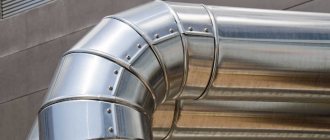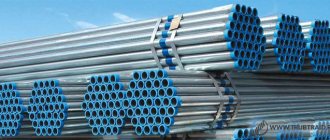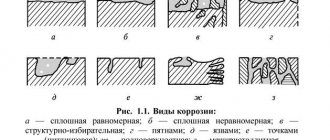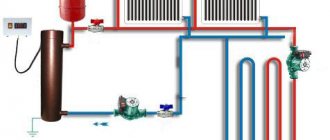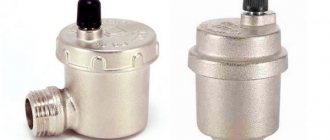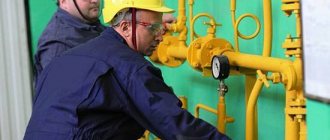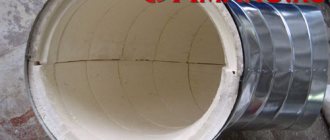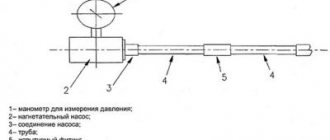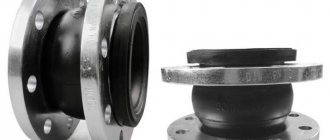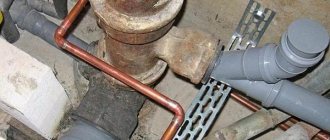Steel pipes, known for a long time, have not lost their popularity in construction, as they can withstand increased loads and resist external influences well, with the possible exception of corrosion. To avoid destruction of heating pipelines as a result of rust formation, the iron is coated with a layer of zinc. The material below is dedicated to the peculiarities of constructing heating networks from galvanized pipes with your own hands.
Galvanized pipes can be used for installation of heating systems
Features of steel pipes
Classic
Conventional ferrous metal pipes have been used in the construction of various buildings and structures for a very long time. Their popularity is due to their ability to withstand increased loads and not collapse under the influence of negative external factors.
Price also has a significant impact on popularity. Carbon steel pipes, having high technical characteristics, are quite affordable.
The materials under consideration are simply created for the construction of heating networks:
- they can transport coolant heated to temperatures above + 100 degrees Celsius;
- If the liquid freezes in the cold season (for example, in the event of a boiler failure), the pipelines can be heated using an open flame.
Steel is strong and reliable, but susceptible to corrosion
But we cannot fail to mention significant disadvantages:
- The process of constructing a heating network from steel pipes is quite labor-intensive and requires special skills and the use of sophisticated equipment.
- It is difficult to give steel pipes the desired geometric shape, especially when you need to bend them in several places at different angles.
- Metal conducts heat well, so when installing a heating network (especially with open areas), you need to carefully protect steel pipes with heat-insulating shells, glass wool or mineral fiber.
- Metal products are highly susceptible to corrosion, so their average service life does not exceed 10-15 years.
As already mentioned, it is the last factor that limits the use of the described materials for the construction of pipelines.
There are two ways to deal with the problem:
- Use polymer parts . There are pipes made from various types of plastic, many of which are successfully used in the construction of heating systems for houses and apartments. However, they are not able to withstand more internal pressure and very high coolant temperatures.
Plastic pipes are not subject to corrosion, but have low strength
Another disadvantage of plastic pipes is their low strength, especially to impact.
- Coat the steel pipe with a protective layer of zinc . In this case, corrosion can be avoided, but only when water is used as the heat transfer fluid. Antifreeze, being chemically active, will reduce all the benefits of galvanizing to zero.
However, a heating system made of galvanized pipes is more reliable, so it makes sense to describe these parts in more detail.
Galvanized
Galvanizing a pipe helps to reliably protect it from corrosion and extend its service life for several years.
Note! Not only steel products are coated with a protective layer of zinc. These can be cast iron pipes, as well as other products intended for transporting liquids.
The instructions for the manufacture of galvanized pipes provide two main methods for applying a protective layer:
- Hot. The finished steel part is immersed in a container filled with liquid zinc at a temperature of + 450 degrees Celsius.
The photo shows the process of hot-dip galvanizing steel parts
- Diffusion. In this case, zinc does not just create a protective layer. Thanks to a special technology, the atoms of the two materials mutually penetrate each other, forming a strong coating that resists oxidation.
For diffusion processing, not liquid, but powdered zinc is used. Pipes are placed in special containers, where special reactions occur that give the pipe not only mechanical, but also electrochemical strength.
Note! Diffusion coating is applied only to steel pipe, since other materials are not able to interact with zinc in this way.
Diffusion galvanizing coats pipes with a more reliable protective layer
Advantages and disadvantages
Most of the parameters of galvanized VGP pipes, both positive and negative, are similar to the parameters of products made of black steel, but there are also individual qualities.
Good qualities
- Strength (especially tensile strength).
- Fire resistance.
- A small indicator of temperature extensions.
- Completely sealed.
- Impact resistance.
- Durability.
- Possibility of use as a heat exchanger.
- Possibility of the installation process, including routine repairs, with your own hands.
- Two assembly methods (welding, threaded fastening connection).
- Easy to recycle.
The advantage of steel gas pipeline pipes is that the external laying of a gas pipeline from the main to consumers is allowed only from steel material.
Minuses
- Significant specific gravity.
- Conductivity of electricity.
- High heat conductivity (need to insulate pipes in heating and hot water systems).
- Tendency to corrosion when zinc protection is damaged.
Independent design of a heating system
When making a climate network from galvanized steel pipes, two types of connections can be used:
- electric or gas welded;
- using threaded fittings.
It should be noted that both the first and second methods require the master to have certain construction skills. If you doubt your abilities, it is better to entrust the installation procedure to experienced plumbers.
Welding
The heating manufacturing process by welding consists of the following steps:
- Vertical main risers (supply and return) are installed, and then horizontal wiring is made from them to each central heating radiator.
Advice! If you are modernizing an old heating system, it is advisable to install pipes according to the old scheme, replacing them sequentially. Such utility networks are very carefully designed and tested, so there is no need to make major changes unless necessary.
Welding is a responsible and complex process
- Gas welding is performed using special solder with a thickness of 0.8 to 1.2 mm. If electric welding is used, it is necessary to use electrodes with calcium fluoride or rutile coating with a diameter of up to 3 mm. Otherwise, a tight connection cannot be achieved.
- Galvanized pipes, unlike conventional steel pipes, are welded overlapping. To do this, one of the parts is slightly flared.
When welding pipes with a protective coating, increased attention should be paid to the quality of the seam. The joint should not have sagging, chips, cracks or other defects.
The same care must be taken to make holes for pipes and fittings. You can use a drill, a milling machine, or cut out a hole using a press.
It is necessary to carefully monitor the quality of seams
If you have basic skills in working with a welding machine and decide to install galvanized pipes yourself, when carrying out operations you must adhere to the following tips:
- the seam must begin from the central part of the part, starting from the floor and gradually moving upward;
- the electrode should be positioned strictly perpendicular to the surface of the product (otherwise it will be impossible to make a high-quality joint);
- if welding is performed on a vertical surface, the electrode must be positioned at an angle, pointing it from top to bottom;
- To achieve the best quality, spot welding technology can be used.
Note! Welding galvanized pipes is practically not used. Under the influence of high temperatures, the protective layer completely evaporates, as a result of which the joints will be susceptible to corrosion, and you will lose all the benefits of using expensive galvanizing. It is better to focus on connection technology that involves the use of threaded fittings.
The welding arc evaporates the protective layer of zinc from the surface of the pipe
Fitting connections
To install a heating system using the twisting method, you need to stock up on the necessary amount of fittings: angles, adapters, shut-off valves, and so on.
Galvanized Threaded Pipe Fittings
Tools of different diameters are also needed for thread cutting. You can use dies, but it is better to purchase a die: this device allows you to make better cuts, avoiding distortions.
In addition, you will need:
- grinder for cutting steel pipes into pieces of the required length;
- a file with which the end chamfer is removed;
- a vice that will help you securely hold workpieces while working with them;
- gas wrenches for twisting fittings and pipes (preferably torque wrenches - they will not damage the threads of the fitting by dosing the force).
The cutting process usually does not cause difficulties even for a novice master, but here several features need to be taken into account:
- When measuring pipes, do not forget to take into account the distance that the pipe will enter the fitting when twisted;
It is better to use special equipment for cutting galvanized pipes
- When installing, please note that placing the pipe too close to the wall will not make it possible to cut a thread (for this you need at least 8-10 cm of free space).
Assembly is not a particularly labor-intensive task.
Here, novice masters make only two common mistakes:
- Distortion of products along the longitudinal axis. If the pipe and fittings are not aligned accurately, the threads may be damaged. Because of this, it will be impossible to achieve the required tightness, and damaged parts will have to be replaced with new ones.
- A fitting or valve is overtightened. It often happens when screwing on faucets that the master wants to tighten the nut a little more so that the faucet handle can move more freely. Most often this leads to breakdown.
Complete disassembly and winding of additional layers of polymer tape or tow will help to cope with the situation.
Connection with radiators
Another important installation stage is connecting pipes to heating radiators. For this purpose, a special type of fittings is used - squeegees.
The operation is performed according to the following scheme:
- the bend is screwed onto the pipe until the distance between its cut and the inlet pipe of the battery reaches 5 mm;
- tow is wound onto the radiator inlet pipe (along the thread);
Squeegees for connecting pipes to radiators
- the bend is screwed onto the thread until the force becomes noticeable, but not excessive;
- The joints can be painted to prevent corrosion.
Connection methods
Pipe joining is done in two ways:
- Threaded connection through a fitting.
- Welding.
Most connections of galvanized pipes are made using threaded fittings. The joints are sealed using plumbing flax, which has been tested for decades. Only instead of the outdated red lead, they coat it with ordinary silicone sealant.
Welding leads to damage to the zinc coating and further corrosion of the metal in this area. To reduce the negative aspects of this operation, various welding methods are used.
